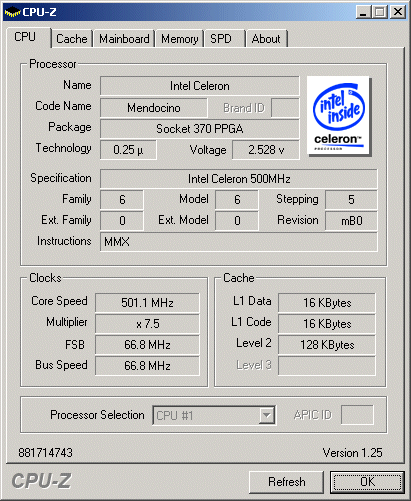The Mother of All CPU Charts Part 1
Socket 370: April 1998 To July 2001
| Intel Celeron 233 to 533 | April 1998 to January 2000 |
| Pentium III/500 to 1133 | October 1999 to July 2001 |
| Celeron II/533 to 1100 | January 2000 to July 2001 |
| Celeron/Pentium III/1000 to 1400 | January 2000 to July 2001 |
There were many users who left out Slot 1 as a processor platform for reasons of cost. Because as early as 1998 the next development was ready: Socket 370, for which there were two case variations - the PPGA and the FC-PGA. The PPGA was predominantly used in OEM systems because it was cheaper to manufacture. In the aforementioned, only the Celeron was used in the plastic package; the Pentium III CPUs came in the more expensive FC-PGA package. And there was one exception: The Celeron with Mendocino core could be used in both sockets. But there was also help: using an adapter, the PPGA CPUs could also be used in Slot 1; for the FC-PGA version there was no adapter.
Adapter of Slot 1 on Socket 370. The settings for the voltage and bus speed had to be defined manually.
For a long time, the CPUs for Slot 1 and Socket 370 were being made and sold simultaneously, although the Pentium III (Coppermine) from 1 GHz clock speed and up met its end in Slot 1.
The last core for Socket 370 was the Tualatin, which meant a transformation (shrink) from 180 nm to 130 nm. The Pentium III-S was made with up to 1.4 GHz and a 512 kB L2 cache. Moreover, this core had data prefetch expansions, which were the forerunner of the micro-ops of today's Pentium 4.
The last Socket 370 CPU, the Pentium III-S Tualatin with 1.4 GHz
Get Tom's Hardware's best news and in-depth reviews, straight to your inbox.
Current page: Socket 370: April 1998 To July 2001
Prev Page Intel Processors From March 1994 To December 2004, Continued Next Page Socket 370: April 1998 To July 2001, ContinuedTom's Hardware is the leading destination for hardcore computer enthusiasts. We cover everything from processors to 3D printers, single-board computers, SSDs and high-end gaming rigs, empowering readers to make the most of the tech they love, keep up on the latest developments and buy the right gear. Our staff has more than 100 years of combined experience covering news, solving tech problems and reviewing components and systems.



